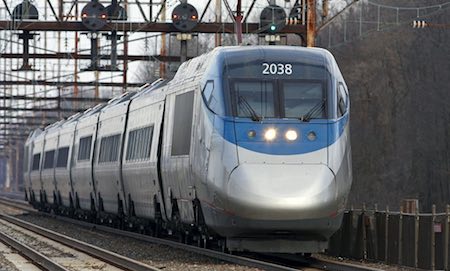
Although Amtrak has made significant progress in installing positive train control (PTC), the railroad hasn’t fully tallied up the total cost of implementing the technology, according to Amtrak’s Office of Inspector General (OIG).
The total cost could be “hundreds of millions more than is currently budgeted,” according to the OIG’s report. If the railroad fails to properly account for the cost of implementing PTC, it may miss the federal government’s end-of-2018 deadline to install the technology.
In addition, Amtrak needs to complete several remaining tasks, including finishing trackside installations. The national passenger railroad has operational PTC systems on track it owns or operates along the Northeast Corridor (NEC) and in Pennsylvania and Michigan. However, that is about 67 percent or 608 route miles of Amtrak’s total planned trackside installation.
And while the railroad has fully installed PTC on nearly all of its locomotives on the NEC, it still must install on-board systems on the 303 locomotives that travel on its long-distance and state-supported routes, according to the OIG.
“Completing these tasks by December 2018 could be challenging given their complexity and the company’s current program management approach, which diffuses accountability and leaves the company vulnerable to cost and schedule risks,” the report stated.
Other remaining PTC-related tasks include:
• submitting a safety plan to the Federal Railroad Administration (FRA) for the approval of the Advanced Civil Speed Enforcement System (ACSES) PTC system on the NEC and connecting rail corridors;
• installing the Interoperable-Electronic Train Management System (I-ETMS) PTC system on segments of the NEC and on segments between Philadelphia and Harrisburg, Pa.;
• upgrading ACSES technical standards to meet FRA interoperability requirements; and
• resolving issues of potential radio frequency spectrum interference with ACSES on the northern end of the NEC.
The OIG recommended that Amtrak re-evaluate current program cost estimates “consistent with leading practices” and ensure that the cost are disclosed in the railroad’s financial plans, including the likely cost of reimbursing host railroads.
Those steps will help ensure sufficient funds are available to complete PTC installation by the 2018 deadline, the report said.
The OIG also suggested that Amtrak clarify the roles and responsibilities of current PTC managers to ensure clear authority and accountability for managing all remaining implementation tasks. The railroad should appoint a senior official with sufficient authority to ensure program success, the OIG said.
Finally, the report suggested that Amtrak identify all remaining implementation tasks and milestones for completion and establish a process to periodically review the status of these remaining actions to measure progress.
Amtrak agreed to all of the OIG’s recommendations.
Railroads can request an additional two-year extension to implement PTC if they meet several prerequisites, including the installation of all PTC hardware and acquisition of all spectrum necessary by December 2018.
CN, CSX and Norfolk Southen Railway are targeting 2020 for full implementation of the technology, according to the FRA’sAugust status report on the railroads’ PTC plans.
